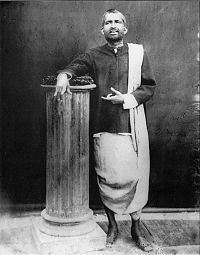User:Goethean/SRK/Teachings/Goethean
Teachings
God-realisation

The key concepts in Ramakrishna’s teachings were the oneness of existence; the divinity of all living beings; and the unity of God and the harmony of religions.
Ramakrishna emphasised that God-realisation is the supreme goal of all living beings.
Kamini-kanchan
Ramakrishna taught that that the primal bondage in human life is to kaminikanchan, or "women and gold". Devotees insist that this phrase warns against lust and greed, but religion scholars and historians have tended to take it more literally. He seems to have overcome sexual desires by "becoming female":
- A man can change his nature by imitating another's character. By transposing onto yourself the attributes of a woman, you gradually destroy lust and the other sensual drives. You begin to behave like a women. I have noticed that men who play female parts in the theater speak like women or brush their teeth like women while bathing.[2]
Various scholars have come to opposing conclusions about Ramakrishna's attitude toward women. Some say that he was simply an ascetic and avoided lust in order to retain mystical clarity.[citation needed] Others say that he feared women deeply or pathologically, especially women as sexual beings.[citation needed] Narasingha Sil links this to traditional rural Bengali misogyny.[3] Sil also says that Ramakrishna made his wife into a deity in order to avoid thinking of her as sexual.[4]
Avidyamaya and vidyamaya
Devotees believe that Ramakrishna’s realisation of nirvikalpa samadhi also led him to an understanding of the two sides of
Harmony of religions
Ramakrishna recognised differences among religions but realised that in spite of these differences, all religions lead to the same ultimate goal, and hence they are all valid and true. Regarding this, the distinguished British historian Arnold J. Toynbee has written: “… Mahatma Gandhi’s principle of non-violence and Sri Ramakrishna’s testimony to the harmony of religions: here we have the attitude and the spirit that can make it possible for the human race to grow together into a single family – and in the Atomic Age, this is the only alternative to destroying ourselves.” [5]
Other teachings
Ramakrishna’s proclamation of jatra jiv tatra Shiv (wherever there is a living being, there is Shiva) stemmed from his Advaitic perception of Reality. This would lead him teach his disciples, "Jive daya noy, Shiv gyane jiv seba" (not kindness to living beings, but serving the living being as Shiva Himself). This view differs considerably from what Ramakrishna’s followers call the "sentimental pantheism" of, for example, Francis of Assisi.
Ramakrishna, though not formally trained as a
Like
The idea of the descent of consciousness shows the influence of the
Notes
- ^ Kathamrita, 1/10/6
- ^ Parama Roy, Indian Traffic: Identities in Question in Colonial and Post-Colonial India Berkeley: University of California Press, 1998
- ^ Sil, Divine Dowager, p. 52
- ^ Sil, Divine Dowager, p. 55
- ^ Contributions of Sri Ramakrishna to World Culture
- ^ Hixon, Lex, Great Swan: Meetings with Ramakrishna, (New Delhi: Motilal Banarsidass, 1992, 2002), p. xvi
- ^ Gospel of Ramakrishna, vol. 4
- ^ Das, Prafulla Kumar, "Samasamayik Banglar adhymatmik jibongothone Sri Ramakrishner probhab", in Biswachetanay Ramakrishna, (Kolkata: Udbodhon Karyaloy, 1987,1997- 6th rep.), pp.299-311
